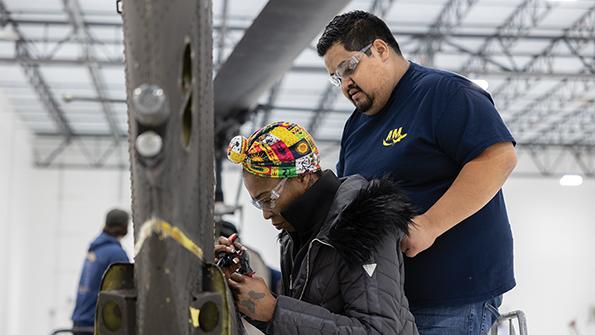Opinion: Industry Collaboration Needed To Solve MRO's Workforce Crisis

AeroProfessional’s research shows candidates prioritize careers with a stable and progressive future.
The shortage of aviation professionals has been widely documented over the past decade, with discussions of demand outstripping supply at the center of the conversation. Even prior to that, 2009 saw the International Civil Aviation Organization establish the Next Generation of Aviation Professionals task force in a bid to address the anticipated shortage.
Fast forward to 2023 and—even in the wake of a global pandemic that caused extensive disruption and resulted in mass redundancies across the sector—the conversation remains unchanged.
The pilot shortage is, of course, a key topic, but the shortfall of engineers is creating a quieter storm behind the scenes as those who maintain aircraft face their own workforce challenges.
The shortage flies in the face of growing demand for air travel. Airbus estimates that passenger traffic will double by 2041, requiring 2 million new personnel, of which 34% will be engineers, while Boeing suggests that more than 600,000 new engineers will be needed in the next 20 years. Both OEMs forecast engineering demand to be higher than pilot demand.
AeroProfessional provides recruitment services for segments such as flight crew, cabin crew and engineers, along with more niche skills such as Continuing Airworthiness Management Organization services, management and operations, leasing, brokerage and executive search. Despite this wide range of roles, our delivery has nearly always been dominated by demand for pilots and cabin crew. However, we have recently seen a shift in this trend. In 2022 technical- and engineering-based roles accounted for 37% of our total vacancies, which is in sharp contrast to 2019, when they accounted for just 18% of total client requirements.
We are already seeing demand growing at pace with employers struggling to fulfill their needs. The situation is exacerbated by the pandemic, which resulted in attrition at record rates as many took early retirement or found work in alternative sectors. Additionally, aircraft engineering is an aging workforce, with as many as one-third of workers approaching retirement and nowhere near enough new talent—mostly due to a 2-3-year pause in training due to the pandemic. This is without taking into consideration the impact of Brexit on the UK labor market.
Aircraft engineering is a rewarding industry, but the younger generation does not know enough about it. We need to invest in talent attraction from an earlier age, helping students gain an understanding of the occupation through energized learning, role models, site visits and internships. Better coordination with educational institutions and governments will raise awareness for STEM-focused careers like aerospace engineering.
Additionally, as we are seeing large numbers of engineers defecting from the industry, retaining the existing workforce should be an absolute priority. While shortages are driving up salaries, pay is only one factor that increases retention. Our research indicates that candidates value careers with a stable and progressive future. It is therefore vital for the industry to provide clear routes for continued growth through additional training, mentoring, management and leadership programs.
We know there is a need to create a strong pipeline of future engineers, but what happens when that pipeline is realized and training capacity becomes another issue?
This is where the collective industry could step in to support future talent and ease bottlenecks. Some airlines, OEMs and MROs already offer apprenticeships, but there are not enough supporting this route to handle the capacity needed. If more organizations adopted this and worked with industry and governments to place a spotlight on them for the next generation, we could see holdups easing.
Equally, as the next generation of aircraft start taking to the skies, the training required to maintain them must also evolve. It is vital to seek out ways of improving the process, supporting new cutting-edge training mechanisms and championing different learning styles to see a steady pipeline of talent ready to fulfill those expanded apprenticeship slots.
It will take a concerted effort from all stakeholders to attract talent and future-proof the engineer pipeline. This will require significant planning and investment in all forms—time, money and resources.
The bottom line is the industry needs to get back to investing in talent attraction at grass roots, integrating an ongoing selection process and then streamlining training to avoid watching its aircraft sit empty on the tarmac.
The decreasing popularity must be addressed to mitigate the problem for the long term. Change must happen now to protect aviation’s future and keep aircraft in the skies. Future demand necessitates it.
Sam Sprules, managing director of AeroProfessional, leads a team of specialists to deliver recruitment solutions for airlines and aircraft operators.




